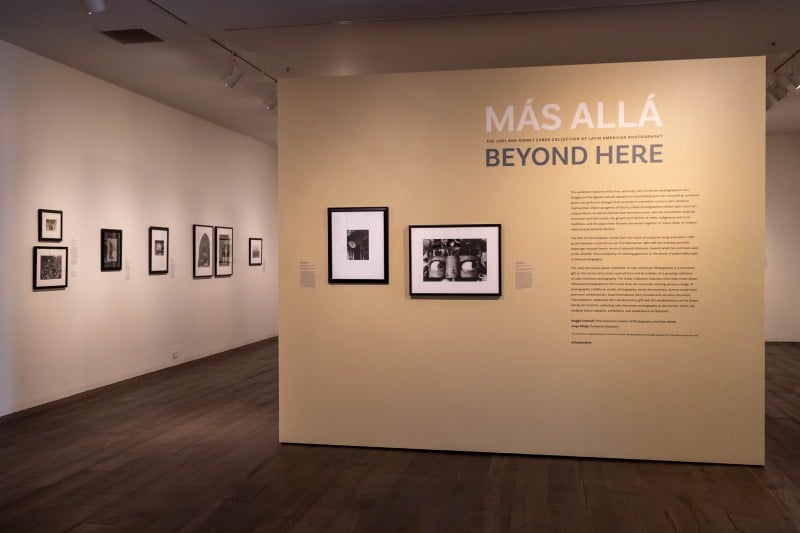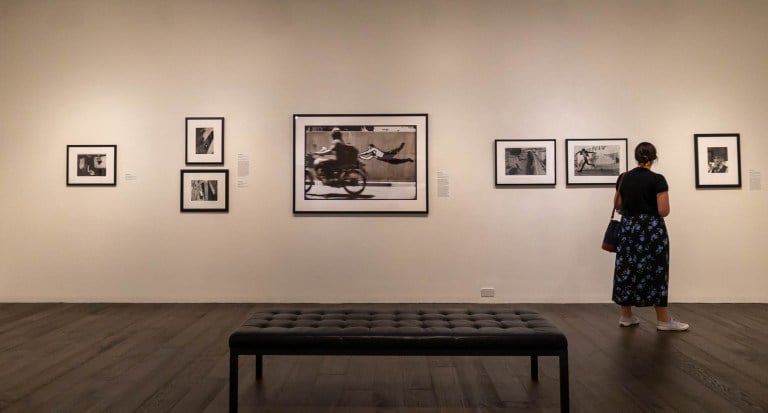“The photographer here engages his sitter as a co-author in the performance of a fiction,” read the description of “El Hombre Araña” (or “Spider Man”), a photograph of a man with a tarantula on his forehead. This sentiment echoed through my head as I walked through the must-see photo exhibition “Más Allá: The Judy and Sidney Zuber Collection of Latin American Photography,” on view at the Cantor Arts Center until Jan. 28, 2024.
“Más Allá” (or Spanish for “Beyond Here”) displays 34 photographs that take the viewer on a physical journey through time and space. The black-and-white photos illustrate the Latin American experience — from the Indigenous peoples’ stories to the Cuban and Mexican Revolutions — through images of festivals and people’s daily activities.

A photo on the center wall drives home the exhibit’s message with a poignant description: “La Moderna Optician” (“The Modern Viewpoint”). Featured in Manuel Álvarez Bravo’s 1931 photograph “Parábola Óptica” (“Optical Parable”), the phrase renders “Más Allá” a glance at the past through the lens of the present. The photo simultaneously features imagery of the human eye, which represents the audience’s multiple perspectives.
“Más Allá” evokes a variety of emotions, from the triumph of the Mexican Revolution in Hugo Brehme’s “Emiliano y Eufemio Zapata y Esposas” (1911) (“Emiliano and Eufemio Zapata with Their Wives”) to the elegant and powerful display of motherhood in Mariana Yampolsky’s “Caracia” (1989) (“Caress”). Viewers engage with humor in Alexandre Órion’s “Metabiótica 8” (2003) (“Metabiotics 8”) and pain and disillusionment in Antonio Reynoso’s “Muerte en la Vecindad” (1942) (“Death in the Neighborhood”).
Photos that were clearly posed are beautiful (such as Martín Chambi’s “Torera,” or “Bullfighter”), but it was the candids that spoke volumes.
Manuel Cabrillo’s “Hombre y Sombra” (1955) (“Man and Shadow”) portrays a man working on his home, and Horacio Coppola’s “Calle Corrientes al 3000” (1931) (“3000 Corrientes Street”) captures another man on his way to work. These powerfully depict everyday life in Mexico City and Buenos Aires, displaying the rawness of each moment and peeling back the stereotype that can so often be placed upon people of color (especially during the 20th century).
Examining the photographs, I wondered why their descriptions only contained background information, when there was so much depth that deserved to be discussed. Further, at times I wished there was stronger lighting on the black-and-white photographs to allow a clearer view.
Regardless, the experience of being surrounded by history is more than worth the trek to Cantor. Even though the photographs date back to the early 1900s, there is an element of recollection and relatability in this exhibit for everyone. Sharing in the universal experience that is life, I found myself simply appreciating the “story” in history. In fact, I would have loved to see artifacts of Latin American culture at the exhibit to immerse myself in that physical reality.
At “Más Allá,” I experienced how art evoked thought and conversation in real time. As I sat in front of Raúl Corrales’s “Caballería” (1960) (“Cavalry”) — which depicts an armed uprising of the Cuban Revolution, I overheard viewers discussing Fidel Castro and life in Cuba during the 1960s.
“Más Allá” has the power to bring together people and their stories, past and present.
Editor’s Note: This article is a review and includes subjective thoughts, opinions and critiques.
